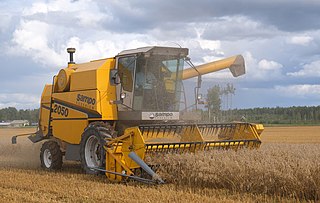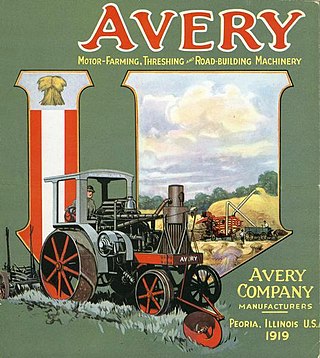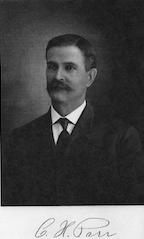
A threshing machine or a thresher is a piece of farm equipment that threshes grain, that is, it removes the seeds from the stalks and husks. It does so by beating the plant to make the seeds fall out.

A tractor is an engineering vehicle specifically designed to deliver a high tractive effort at slow speeds, for the purposes of hauling a trailer or machinery such as that used in agriculture, mining or construction. Most commonly, the term is used to describe a farm vehicle that provides the power and traction to mechanize agricultural tasks, especially tillage, and now many more. Agricultural implements may be towed behind or mounted on the tractor, and the tractor may also provide a source of power if the implement is mechanised.

The modern combine harvester, or simply combine, is a machine designed to harvest a variety of grain crops. The name derives from its combining four separate harvesting operations—reaping, threshing, gathering, and winnowing—to a single process. Among the crops harvested with a combine are wheat, rice, oats, rye, barley, corn (maize), sorghum, millet, soybeans, flax (linseed), sunflowers and rapeseed. The separated straw, left lying on the field, comprises the stems and any remaining leaves of the crop with limited nutrients left in it: the straw is then either chopped, spread on the field and ploughed back in or baled for bedding and limited-feed for livestock.

The Case Corporation was a manufacturer of agricultural machinery and construction equipment. Founded, in 1842, by Jerome Increase Case as the J. I. Case Threshing Machine Company, it operated under that name for most of a century. For another 66 years it was the J. I. Case Company, and was often called simply Case. In the late 19th century, Case was one of America's largest builders of steam engines, producing self-propelled portable engines, traction engines and steam tractors. It was a major producer of threshing machines and other harvesting equipment. The company also produced various machinery for the U.S. military. In the 20th century, Case was among the ten largest builders of farm tractors for many years. In the 1950s its construction equipment line became its primary focus, with agricultural business second.
A horse engine is a machine for using draft horses to power other machinery. It is a type of animal engine that was very common before internal combustion engines and electrification. A common design for the horse engine was a large treadmill on which one or more horses walked. The surface of the treadmill was made of wooden slats linked like a chain. Rotary motion from the treadmill was first passed to a planetary gear system, and then to a shaft or pulley that could be coupled to another machine. Such powers were called tread powers, railway powers, or endless-chain powers. Another common design was the horse wheel or sweep power, in which one or several horses walked in a circle, turning a shaft at the center. Mills driven by horse powers were called horse mills. Horse engines were often portable so that they could be attached to whichever implement they were needed for at the time. Others were built into horse-engine houses.

The Advance-Rumely Company of La Porte, Indiana was an American pioneering producer of many types of agricultural machinery, most notably threshing machines and large tractors. Started in 1853 manufacturing threshers and later moved on to steam engines. Allis-Chalmers Manufacturing Co. purchased Advance-Rumley in 1931. The company's main works would become what was later known as the "La Porte plant".

The Avery Company, founded by Robert Hanneman Avery, was an American farm tractor manufacturer famed for its undermounted engine which resembled a railroad engine more than a conventional farm steam engine. Avery founded the farm implement business after the Civil War. His company built a large line of products, including steam engines, beginning in 1891. The company started with a return flue design and later adapted the undermount style, including a bulldog design on the smokebox door. Their design was well received by farmers in central Illinois. They expanded their market nationwide and overseas until the 1920s, when they failed to innovate and the company faltered. They manufactured trucks for a period of time, and then automobiles. until they finally succumbed to an agricultural crisis and the Depression.

Daniel Best was an American adventurer, businessman, farmer, and inventor known for pioneering agriculture machinery and heavy machinery.

Gaar, Scott & Co., was an American threshing machine and steam traction engine builder founded in 1849 and based in Richmond, Indiana. The company built simple and compound engines in sizes from 10 to 50 horsepower. Farm machinery produced by the firm were advertised as part of "the Tiger Line" and used a tiger upon two globes as the company logo. In the Fall of 1869, A. Gaar & Co. won "Best Portable Farm Steam Engine" and "Best Eight Horse Power" at the 17th Illinois State Fair, for which it won two Silver Medal prizes. It merged with the M. Rumley Co. in 1911 during a purchasing frenzy that put the later firm into insolvency. The company was reorganized as Advance-Rumely Thresher Company Inc. Advance-Rumely Thresher Company was later purchased by Allis-Chalmers Mfg. Co.

Reeves & Co. was an American farm tractor builder for thirty years, based in Columbus, Indiana. It built some of the largest steam traction engines used in North America.

The Oliver Farm Equipment Company was an American farm equipment manufacturer from the 20th century. It was formed as a result of a 1929 merger of four companies: the American Seeding Machine Company of Richmond, Indiana; Oliver Chilled Plow Works of South Bend, Indiana; Hart-Parr Tractor Company of Charles City, Iowa; and Nichols and Shepard Company of Battle Creek, Michigan.
Charles Walter Hart was an American mechanical engineer, inventor, and businessman. Together with Charles Henry Parr, he founded a company that produced a commercially successful line of gasoline-powered tractors. After being forced out of his company in 1917, he went on to work on further development of the tractor and later, started an oil refinery.

Agricultural machinery relates to the mechanical structures and devices used in farming or other agriculture. There are many types of such equipment, from hand tools and power tools to tractors and the countless kinds of farm implements that they tow or operate. Diverse arrays of equipment are used in both organic and nonorganic farming. Especially since the advent of mechanised agriculture, agricultural machinery is an indispensable part of how the world is fed. Agricultural machinery can be regarded as part of wider agricultural automation technologies, which includes the more advanced digital equipment and robotics. While agricultural robots have the potential to automate the three key steps involved in any agricultural operation, conventional motorized machinery is used principally to automate only the performing step where diagnosis and decision-making are conducted by humans based on observations and experience.
The National Threshers Association (NTA) is a non-profit group of enthusiasts who are interested in steam-powered traction engines - also known as "steam tractors", "steam traction engines" or simply "steam engines" - as well as related equipment. The group's premier event is its annual reunion/show, which features live exhibits of antique steam engines and gas-powered machinery from throughout the United States and Canada. Dating back to 1944, the annual show is recognized as the oldest event of its type in the United States.
Threshing is a key part of agriculture that involves removing the seeds or grain from plants from the plant stalk. In the case of small farms, threshing is done by beating or crushing the grain by hand or foot, and requires a large amount of hard physical labour. A simple thresher with a crank can be used to make this work much easier for the farmer. In most cases it takes two people to work these: one person to turn the crank and the other to feed the grain through the machine. These threshers can be built using simple materials and can improve the efficiency of grain threshing. They can also be built with pedals, or be attached to a bicycle, so that the person operating it can simply pedal to reduce the work even more and make threshing faster.

The agricultural machinery industry or agricultural engineering industry is the part of the industry, that produces and maintain tractors, agricultural machinery and agricultural implements used in farming or other agriculture. This branch is considered to be part of the machinery industry.

Charles Henry Parr was an American mechanical engineer, inventor, and pioneer in the development of the gasoline powered agricultural tractor and cofounder of Hart-Parr Company.

Russell & Company of Massillon, Ohio, are best known for manufacturing farm and railroad machinery in the late 19th and early 20th centuries. Most notably 18,000 Steam tractors and Stationary engines, plus 22,000 Threshing machines.














